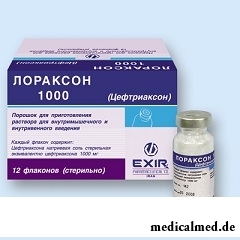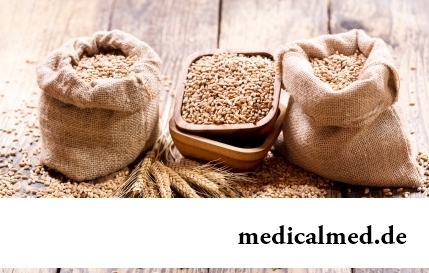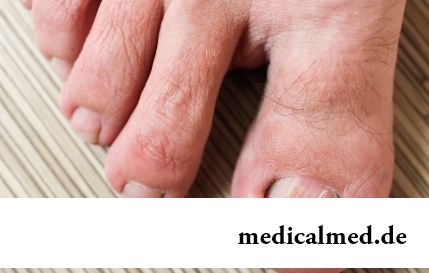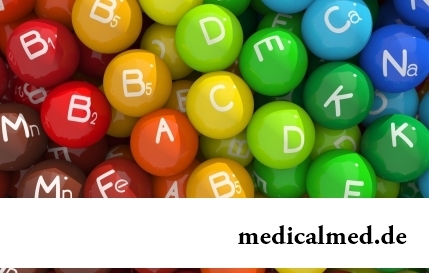





Lorakson
Application instruction:
 Lorakson – a tsefalosporinovy antibiotic of the III generation.
Lorakson – a tsefalosporinovy antibiotic of the III generation.
Form of release and structure
Dosage form – powder for preparation of solution for intravenous (in/in) and intramuscular introduction (in oil): crystal weight from white with a yellow shade till white color (on 0,5 g or 1 g in bottles of 10 ml, in a cardboard pack of 1 or 12 bottles complete with 1 or 12 ampoules of solvent respectively, or without them).
Active ingredient of Lorakson – цефтриаксон (in the form of sodium salt), in 1 bottle – 500 or 1000 mg.
Solvent: water for injections, in 1 ampoule – 5 or 10 ml.
Indications to use
Lorakson's use is shown for treatment of the diseases caused by microorganisms, sensitive to a tseftriakson:
- Meningitis;
- Sepsis;
- Peritonitis, inflammatory pathologies of biliary tract and digestive tract;
- Pneumonia and other respiratory infections;
- Skin infections;
- Infections of urinary tract and kidneys;
- Infections of joints and bones;
- Gonorrhea and other infections of generative organs;
- Infectious and inflammatory diseases in otolaryngology;
- Infections at patients with the lowered immunity.
Besides, drug is appointed for prevention of infections in the postoperative period.
Contraindications
- I trimester of pregnancy;
- Hypersensitivity to cephalosporins and penicillin.
With care need to appoint drug premature children, newborns with a hyperbilirubinemia, at development of enteritis or colitis against the background of reception of antibacterial agents, at nonspecific ulcer colitis, a renal and/or liver failure, in II and III trimesters of pregnancy and during breastfeeding.
Route of administration and dosage
Powder after preparation of solution is entered in/in or in oil.
The recommended rules of dissolution and administration of drug:
- In/in jet introduction: 1 g of powder part in 10 ml of solvent (water for injections), make introduction slowly within 2-4 minutes;
- In/in drop introduction: 2 g of powder dissolve in 40 ml not of calciferous solution (5% or 10% solution of a dextrose, 5% solution of fructose or 0,9% chloride sodium solution), enter infusionally within 30 minutes;
- Injection in oil: 1 g of powder dissolve 1% of solution of lidocaine in 3,5 ml, carry out deep introduction to a gluteus (no more than 1 g of drug in 1 buttock). It is impossible to enter lidocaine solution in/in!
The dose and the period of treatment are appointed by the attending physician on the basis of clinical indications.
The recommended one-time daily dosing of Lorakson has age restrictions:
- Patients are more senior than 12 years: 1-2 g (for the infections caused by moderately sensitive pathogens, and severe forms of a disease increase in a dose to 4 g is allowed);
- Children up to 12 years, including babies: drug is appointed at the rate of 0,02-0,075 g to 1 kg of weight, at a dose higher than 0,05 g on 1 kg of weight it is necessary to administer the drug in/in kapelno within 30 minutes. Children weighing 50 kg are also more recommended to appoint doses for adults;
- The newborn aged up to 2 weeks: at the rate of 0,02-0,05 on 1 kg of weight.
At children, including newborns, treatment of bacterial meningitis begin with a daily dose 0,1 g on 1 kg of weight, the most admissible dose – 4 g a day. The dose needs to be adjusted after allocation of a pathogenic microorganism and definition of its sensitivity. The period of treatment depends on a contagium:
- Meningokokk – 4 days;
- Hemophilic stick (Pfeyfer's stick) – 6 days;
- Pneumococcus – 7 days;
- Sensitive enterobakteriya – 10-14 days.
At treatment of the gonorrhea caused by the strain which is forming and not forming a penicillinase appoint single introduction of 0,25 g in oil of drug.
For prevention of development of an infection against the background of surgical intervention, it is recommended in 1-1,5 hours prior to operation once to enter 1-2 g of a tseftriakson.
Patients with renal failures at clearance of creatinine (KK) is higher than 10 have some and normal function of a liver the dose of a tseftriakson should not be reduced.
At the expressed renal failure (KK less than 10 ml/min.) the daily dose of Lorakson should not exceed 2 g. At patients after carrying out a hemodialysis the dose of drug should not be changed.
At the broken function of a liver and normal function of kidneys the dose should not be reduced. It is regularly necessary to control the level of concentration of a tseftriakson in blood serum at patients with simultaneous heavy pathology of a liver and kidneys.
Side effects
- Alimentary system: taste disturbance, nausea, vomiting, a lock or diarrhea, abdominal pains, a meteorism, a glossitis, a pseudomembranous coloenteritis, stomatitis, dysbacteriosis, an abnormal liver function (in the form of increase in activity of liver enzymes, it is rare – an alkaline phosphatase or bilirubin, cholestatic jaundice);
- System of a hemopoiesis: neutropenia, leukopenia, granulocytopenia, thrombocytopenia, thrombocytosis, lymphopenia, hypocoagulation, hemolitic anemia, lengthening of a prothrombin time, decrease in concentration of plasma factors of coagulation (II, VII, IX, X);
- Urinary system: a renal failure (increase in content of urea in blood), an azotemia, a giperkreatininemiya, a cylindruria, a glucosuria, an oliguria, an anury, a hamaturia;
- Allergic reactions: skin rash, itch, small tortoiseshell, fever or fever; seldom – an eosinophilia, a bronchospasm, a serum disease, a polymorphic exudative erythema (including Stephens-Johnson's syndrome), an acute anaphylaxis, a Quincke's disease;
- Local reactions: morbidity on the vein course, phlebitis, in the place in oil of introduction morbidity and infiltrate;
- Others: dizziness, headache, nasal bleedings, superinfection, candidiasis.
Special instructions
Purpose of drug has to be made on detailed collecting the anamnesis.
It is regularly necessary to control the level of concentration of a tseftriakson in a blood plasma at patients with the simultaneous expressed liver and renal failure and the patients who are on a hemodialysis.
At long therapy it is regularly necessary to control indicators of a functional condition of kidneys and a liver, a picture of peripheral blood.
In rare instances ultrasound examination (ultrasonography) of a gall bladder can note passing blackouts which sometimes are followed by pains in right hypochondrium. In this case the patient should appoint an additional symptomatic treatment and to continue therapy by drug.
During Lorakson's use the use of alcoholic beverages is contraindicated.
In case of development of an acute anaphylaxis, the patient should immediately in/in enter Epinephrinum, and then – a glucocorticosteroid.
At treatment of the elderly and weakened patients there can be a need for purpose of vitamin K.
Considering ability of a tseftriakson to force out the bilirubin connected with blood serum albumine it is necessary to carry out carefully treatment of newborns with a hyperbilirubinemia, especially premature.
Medicinal interaction
Despite a synergism between tseftriaksony and aminoglycosides concerning influence on a significant amount of gram-negative bacteria, at heavy, life-threatening infections of the patient their co-administration is shown. Considering physical incompatibility of drug with aminoglycosides it is necessary to appoint their reception separately in the recommended doses.
Drug is incompatible with ethanol.
At Lorakson's combination to inhibitors of aggregation of thrombocytes, including non-steroidal anti-inflammatory drugs, the probability of bleeding increases. At joint reception with nefrotoksichny drugs (including loopback diuretics) the risk of development of nephrotoxicity increases.
Drug cannot be mixed in one syringe or an infusional bottle with other antibiotic.
Terms and storage conditions
To store in the place protected from light at a temperature up to 25 °C. To protect from children.
Period of validity – 2 years.
Except people, only one living being on the planet Earth – dogs suffers from prostatitis. Here really our most loyal friends.

Doctors claim that the people not so familiar with a dorsodynia occur among adult Russians very seldom. At the same time подавляющ...
Section: Articles about health
The immunity role in growth of the child is invaluable. The proteins-immunoglobulins produced by immune system preserve the child against the diseases capable − owing to an organism weak still − to serve as a stressful factor, to become the reason of many complications and delays in unless...
Section: Articles about health
The concept "gluten" (differently, a gluten) combines group of the proteins which are a part of rye, barley and wheat. For most of people the use of the food stuffs containing a gluten not only is safe, but also it is very useful. Nevertheless, there is a number of myths about negative effect which allegedly gluten has on health of the person....
Section: Articles about health
Several decades ago the basil (the district khan, реан, Reagan) was considered as a part of the Caucasian or east cuisine, but today it is strong for...
Section: Articles about health
Antibiotics - - it is possible to call the chemical compounds suppressing growth of bacteria the break in the field of medicine which allowed to save mankind from many diseases incurable earlier: tuberculosis, plague, syphilis and many others. A contribution of drugs to rescue of people from...
Section: Articles about health
Radiological methods of a research are applied in medicine more than hundred years, and thanks to them millions of lives were saved. In many cases without X-ray it is impossible to make exact idea of a condition of bodies and fabrics, it is correct to make the diagnosis. Nevertheless, many myths about researches such continue to exist. Let's consider the most widespread of them....
Section: Articles about health
Hemorrhoids – extremely widespread disease. Periodically arising inflammations and bleeding of hemorrhoidal nodes пр...
Section: Articles about health
Feeding by a breast - the integral part of ideal motherhood allowing to come into contact with the kid and to create to it healthy immunity since early years. Nevertheless, this important process in life of mother and child can be saddened laktostazy − by a delay of milts...
Section: Articles about health
To look healthy and means well-groomed not only to be pleasant to people around, but also to feel strong, sure and taken place. Specialists in the field of cosmetology quite often note that not all women are able to look after face skin. Many women incorrectly apply cosmetics, ineptly use various procedures, without having exact information on their real influence and dividing numerous delusions about it. All this not the best...
Section: Articles about health
The phenomenon of improvement of a condition of the patients at administration of drugs who are not containing active agents, so-called effect of placebo is known...
Section: Articles about health
The word "onikhokriptoz" is unfamiliar to most of people, meanwhile quite so physicians call very widespread problem: the growing of edge of a nail into surrounding fabrics causing inflammatory process. Usually the illness affects thumbs of legs, and is followed покр...
Section: Articles about health
Each of us faces from time to time that other people need the immediate help. We react to it differently: one at once call doctors and police, others rush to victims and try to save them independently. Some pass by at all … Certainly, desire to help the neighbor who got into trouble, quite naturally for any decent person. However not everyone understands that to work in a similar situation, being guided by exclusively good...
Section: Articles about health
Sugar - the digestible refined product which is not of special value for an organism of the modern person. Use...
Section: Articles about health
When overcomes feeling of hunger, and an opportunity to have dinner fully is absent, having a snack − the meals, small on volume, stabilizing sugar level in blood comes to the rescue. The relation of nutritionists to having a snack is more often negative, but only because in кач...
Section: Articles about health
Vitamin complexes belong to the most popular drugs, probably, in our country there is no person who was not hearing about advantage of vitamins and never their accepting. The more vitamins, the better, we consider and as it appeared, cruelly we are mistaken. Whether vitamins, whether so harmlessly general hobby for polyvitaminic complexes and whether it is possible to do without them are so useful? Let's try to understand....
Section: Articles about health
Popular joke that there are no healthy people, and is nedoobsledovanny, most of us considers an honest truth, and put that...
Section: Articles about health
A lot of things depend on a condition of a backbone in a human body, a backbone - not only a support for a body, it also a receptacle for a spinal cord, that is why malfunctions with a backbone are so dangerous. To treat rachis diseases very difficult and long...
Section: Articles about health
In consciousness of our many compatriots idea that folk remedies if are no more effective, than medicinal "chemistry" strongly took roots, then are precisely less harmful. Unfortunately, it is not always fair: some methods of treatment consecrated with "century national experience" can work so on the patient that it will need urgent intervention of physicians....
Section: Articles about health
All got used long ago that, having addressed the plastic surgeon, it is possible to modify natural parameters of a figure or to reduce...
Section: Articles about health
Coffee - the tonic loved by many for the invigorating aroma and deep taste. Having the stimulating effect, coffee increases working capacity, promotes concentration of attention, fights against drowsiness and improves mood. Statistically, about 30% of inhabitants...
Section: Articles about health
At this plant there are a lot of names: tuberiferous sunflower, Jerusalem artichoke, solar root, earth pear. Contrary to popular belief, it is not an exotic plant at all. The wild girasol grows in a midland of Russia practically everywhere: at the edges of roads, to slopes of ravines, on heathlands. Also several cultural versions different from wild plants are removed by larger and juicy root crops....
Section: Articles about health
Childbirth is the most important event in life of each woman. We are women we give birth to the new little man on this light. Now...
Section: Articles about health
Quite large number of people adheres to the principles of vegetarian food. But how to be if in a family of vegetarians there are children? Whether it is possible to eat also it the same as to parents, or after all the children's organism is not adapted for the use only раст...
Section: Articles about health
Aging — natural and inevitable process. Over time our skin loses elasticity, on it saggings are formed, the face form loses former clearness. The procedure of nitevy lifting (nitevy tightening) can successfully solve this problem. In order that it is better to get acquainted with this popular procedure, we will tell you 6 cognitive facts about it....
Section: Articles about health
Life does not indulge the modern woman special emotional comfort and carelessness. Fatigue, troubles at work, misunderstanding...
Section: Articles about health
Eyes – unique body on the structure thanks to which the person obtains about 80% of information on the world around: about a form, color, size, the movement, and also many other parameters of objects or phenomena. But whether much we know about the most valuable body...
Section: Articles about health
Tick-borne encephalitis – one of the most dangerous viral diseases which causative agents transfer and is given to people by ixodic mites. These are the small blood-sicking insects living in the considerable territory of our country. The person bitten by a tick can catch also erlikhiozy, bartonnelezy, babeziozy, mycoplasmosis and Lyme's disease. As well as encephalitis, these illnesses affect the central nervous system, and as specific antiviral therapy does not exist, the forecast very to a neuta...
Section: Articles about health
